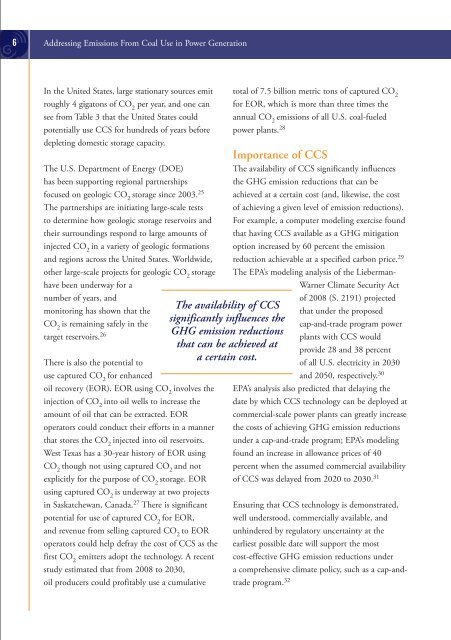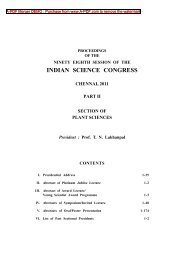Addressing Emissions From Coal Use in Power Generation ...
Addressing Emissions From Coal Use in Power Generation ...
Addressing Emissions From Coal Use in Power Generation ...
You also want an ePaper? Increase the reach of your titles
YUMPU automatically turns print PDFs into web optimized ePapers that Google loves.
6 <strong>Address<strong>in</strong>g</strong> <strong>Emissions</strong> <strong>From</strong> <strong>Coal</strong> <strong>Use</strong> <strong>in</strong> <strong>Power</strong> <strong>Generation</strong><br />
In the United States, large stationary sources emit<br />
roughly 4 gigatons of CO 2<br />
per year, and one can<br />
see from Table 3 that the United States could<br />
potentially use CCS for hundreds of years before<br />
deplet<strong>in</strong>g domestic storage capacity.<br />
The U.S. Department of Energy (DOE)<br />
has been support<strong>in</strong>g regional partnerships<br />
focused on geologic CO 2<br />
storage s<strong>in</strong>ce 2003. 25<br />
The partnerships are <strong>in</strong>itiat<strong>in</strong>g large-scale tests<br />
to determ<strong>in</strong>e how geologic storage reservoirs and<br />
their surround<strong>in</strong>gs respond to large amounts of<br />
<strong>in</strong>jected CO 2<br />
<strong>in</strong> a variety of geologic formations<br />
and regions across the United States. Worldwide,<br />
other large-scale projects for geologic CO 2<br />
storage<br />
have been underway for a<br />
number of years, and<br />
monitor<strong>in</strong>g has shown that the<br />
CO 2<br />
is rema<strong>in</strong><strong>in</strong>g safely <strong>in</strong> the<br />
target reservoirs. 26<br />
There is also the potential to<br />
use captured CO 2<br />
for enhanced<br />
oil recovery (EOR). EOR us<strong>in</strong>g CO 2<br />
<strong>in</strong>volves the<br />
<strong>in</strong>jection of CO 2<br />
<strong>in</strong>to oil wells to <strong>in</strong>crease the<br />
amount of oil that can be extracted. EOR<br />
operators could conduct their efforts <strong>in</strong> a manner<br />
that stores the CO 2<br />
<strong>in</strong>jected <strong>in</strong>to oil reservoirs.<br />
West Texas has a 30-year history of EOR us<strong>in</strong>g<br />
CO 2<br />
though not us<strong>in</strong>g captured CO 2<br />
and not<br />
explicitly for the purpose of CO 2<br />
storage. EOR<br />
us<strong>in</strong>g captured CO 2<br />
is underway at two projects<br />
<strong>in</strong> Saskatchewan, Canada. 27 There is significant<br />
potential for use of captured CO 2<br />
for EOR,<br />
and revenue from sell<strong>in</strong>g captured CO 2<br />
to EOR<br />
operators could help defray the cost of CCS as the<br />
first CO 2<br />
emitters adopt the technology. A recent<br />
study estimated that from 2008 to 2030,<br />
oil producers could profitably use a cumulative<br />
The availability of CCS<br />
significantly <strong>in</strong>fluences the<br />
GHG emission reductions<br />
that can be achieved at<br />
a certa<strong>in</strong> cost.<br />
total of 7.5 billion metric tons of captured CO 2<br />
for EOR, which is more than three times the<br />
annual CO 2<br />
emissions of all U.S. coal-fueled<br />
power plants. 28<br />
Importance of CCS<br />
The availability of CCS significantly <strong>in</strong>fluences<br />
the GHG emission reductions that can be<br />
achieved at a certa<strong>in</strong> cost (and, likewise, the cost<br />
of achiev<strong>in</strong>g a given level of emission reductions).<br />
For example, a computer model<strong>in</strong>g exercise found<br />
that hav<strong>in</strong>g CCS available as a GHG mitigation<br />
option <strong>in</strong>creased by 60 percent the emission<br />
reduction achievable at a specified carbon price. 29<br />
The EPA’s model<strong>in</strong>g analysis of the Lieberman-<br />
Warner Climate Security Act<br />
of 2008 (S. 2191) projected<br />
that under the proposed<br />
cap-and-trade program power<br />
plants with CCS would<br />
provide 28 and 38 percent<br />
of all U.S. electricity <strong>in</strong> 2030<br />
and 2050, respectively. 30<br />
EPA’s analysis also predicted that delay<strong>in</strong>g the<br />
date by which CCS technology can be deployed at<br />
commercial-scale power plants can greatly <strong>in</strong>crease<br />
the costs of achiev<strong>in</strong>g GHG emission reductions<br />
under a cap-and-trade program; EPA’s model<strong>in</strong>g<br />
found an <strong>in</strong>crease <strong>in</strong> allowance prices of 40<br />
percent when the assumed commercial availability<br />
of CCS was delayed from 2020 to 2030. 31<br />
Ensur<strong>in</strong>g that CCS technology is demonstrated,<br />
well understood, commercially available, and<br />
unh<strong>in</strong>dered by regulatory uncerta<strong>in</strong>ty at the<br />
earliest possible date will support the most<br />
cost-effective GHG emission reductions under<br />
a comprehensive climate policy, such as a cap-andtrade<br />
program. 32

















